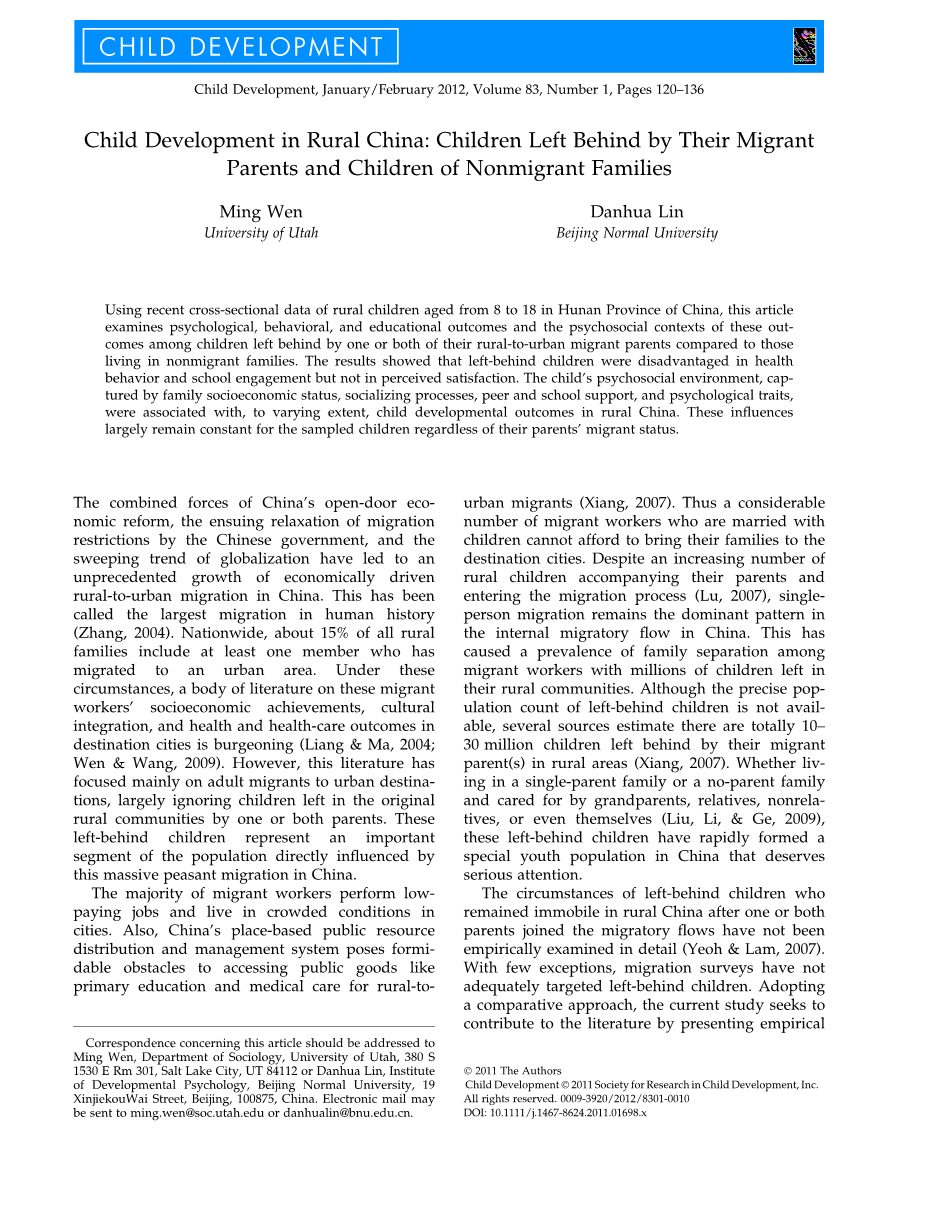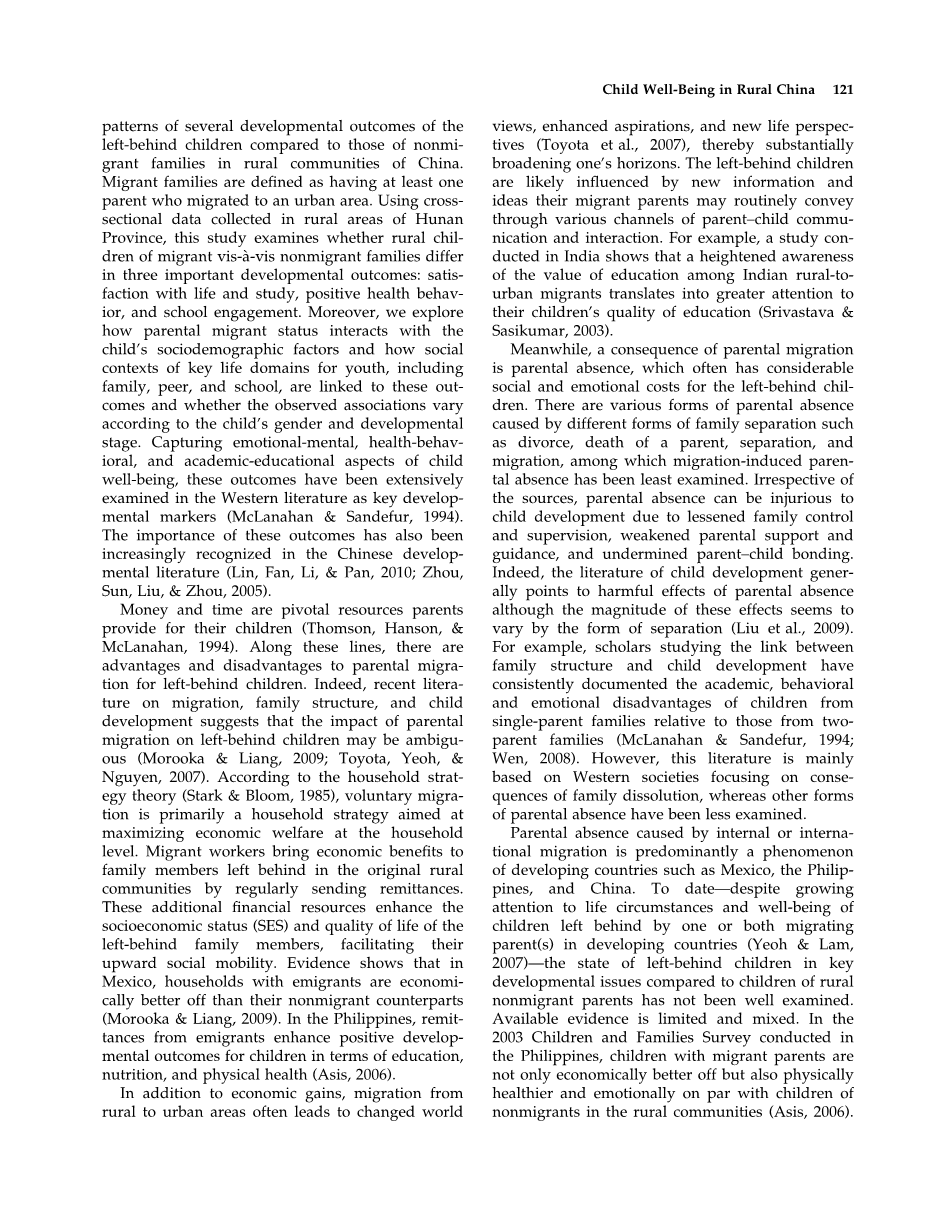英语原文共 17 页,剩余内容已隐藏,支付完成后下载完整资料
目 录
Social Contexts of Child Development 6
英文原文
Child Development in Rural China: Children Left Behind by Their Migrant Parents and Children of Nonmigrant Families
Introduction
Using recent cross-sectional data of rural children aged from 8 to 18 in Hunan Province of China, this article examines psychological, behavioral, and educational outcomes and the psychosocial contexts of these out- comes among children left behind by one or both of their rural-to-urban migrant parents compared to those living in nonmigrant families. The results showed that left-behind children were disadvantaged in health behavior and school engagement but not in perceived satisfaction. The childrsquo;s psychosocial environment, captured by family socioeconomic status, socializing processes, peer and school support, and psychological traits, were associated with, to varying extent, child developmental outcomes in rural China. These influences largely remain constant for the sampled children regardless of their parentsrsquo; migrant status.
The combined forces of Chinarsquo;s open-door economic reform, the ensuing relaxation of migration restrictions by the Chinese government, and the sweeping trend of globalization have led to an unprecedented growth of economically driven rural-to-urban migration in China. This has been called the largest migration in human history (Zhang, 2004). Nationwide, about 15% of all rural families include at least one member who has migrated to an urban area. Under these circumstances, a body of literature on these migrant workersrsquo; socioeconomic achievements, cultural integration, and health and health-care outcomes in destination cities is burgeoning (Liang amp; Ma, 2004; Wen amp; Wang, 2009). However, this literature has focused mainly on adult migrants to urban destinations, largely ignoring children left in the original rural communities by one or both parents. These left-behind children represent an important segment of the population directly influenced by this massive peasant migration in China.
The majority of migrant workers perform low- paying jobs and live in crowded conditions in cities. Also, Chinarsquo;s place-based public resource distribution and management system poses formidable obstacles to accessing public goods like primary education and medical care for rural-to-urban migrants (Xiang, 2007). Thus a considerable number of migrant workers who are married with children cannot afford to bring their families to the destination cities. Despite an increasing number of rural children accompanying their parents and entering the migration process (Lu, 2007), single- person migration remains the dominant pattern in the internal migratory flow in China. This has caused a prevalence of family separation among migrant workers with millions of children left in their rural communities. Although the precise population count of left-behind children is not avail- able, several sources estimate there are totally 10– 30 million children left behind by their migrant parent(s) in rural areas (Xiang, 2007). Whether living in a single-parent family or a no-parent family and cared for by grandparents, relatives, non-relatives, or even themselves (Liu, Li, amp; Ge, 2009), these left-behind children have rapidly formed a special youth population in China that deserves serious attention.
The circumstances of left-behind children who remained immobile in rural China after one or both parents joined the migratory flows have not been empirically examined in detail (Yeoh amp; Lam, 2007). With few exceptions, migration surveys have not adequately targeted left-behind children. Adopting a comparative approach, the current study seeks to contribute to the literature by presenting empirical patterns of several developmental outcomes of the left-behind children compared to those of nonmigrant families in rural communities of China. Migrant families are defined as having at least one parent who migrated to an urban area. Using cross- sectional data collected in rural areas of Hunan Province, this study examines whether rural children of migrant virsus nonmigrant families differ in three important developmental outcomes: satisfaction with life and study, positive health behavior, and school engagement. Moreover, we explore how parental migrant status interacts with the childrsquo;s sociodemographic factors and how social contexts of key life domains for youth, including family, peer, and school, are linked to these out- comes and whether the observed associations vary according to the childrsquo;s gender and developmental stage. Capturing e
剩余内容已隐藏,支付完成后下载完整资料
资料编号:[254707],资料为PDF文档或Word文档,PDF文档可免费转换为Word
以上是毕业论文外文翻译,课题毕业论文、任务书、文献综述、开题报告、程序设计、图纸设计等资料可联系客服协助查找。




